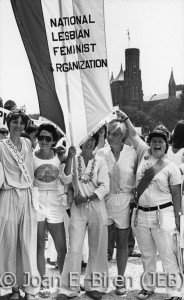To mark the fiftieth anniversary of The Feminine Mystique, CCF hosted an online symposium reflecting on where we are today. Judy Howard offered this short essay on Lesbian Mystiques.
Betty Friedan highlighted the many ways that cultural images and expectations of gender in the 1950s and 60s held women back. The expectations derived most obviously from patriarchy, which Friedan recognized, but also from white supremacy, capitalism, and heterosexism, which she did not. In Friedan’s time the feminine mystique certainly constrained women’s senses of themselves and their possibilities, but at least it recognized women as a group. The “lesbian mystique,” by contrast, denied lesbians even existed. The concept was literally inconceivable. In the 19th century, Queen Victoria is rumored to have flatly proclaimed: “Women don’t do that.”
Of course there were lesbian subcultures and activism throughout the ages, even during the heyday of the feminine mystique. A group of us living in Madison WI at the time, not exactly Friedan’s suburban middle America, organized what we rather inflatedly called a national conference of the National Lesbian Feminist Organization. And there were the womyn’s music festivals, at least one of which continues to this day.
But through most of the 20th century, to the extent that lesbians were recognized at all, they were viewed as masculine, butch, man-hating (ironically) dykes. Femmes were not regarded as similarly lesbian, since they looked like “normal women.” Lesbians were also assumed to be working class – out of the middle class mainstream.These assumptions were held not only by the larger culture, but also by heterosexual feminists, who were worried that recognition of lesbians would endanger the feminist movement. Friedan herself is infamous for coining the phrase, the “lavender menace” in the late 1960s, when the National Organization for Women excluded lesbians.

Photograph by Joan E. Biren (JEB), from Joan E. Biren Papers. Sophia Smith Collection, Smith College, Northampton, MA.
Perhaps in reaction to this invisibility and intolerance, lesbians in the ’70s held images and self-definitions that were also limited in some ways. There was an essentialism about 1970s lesbians, evident in an assumption that lesbian behavior predicted a lifetime of lesbian preference and identity. Other even more profoundly unrecognized identities, especially trans identities, were conflated within lesbianism, complicating the presumed “essences” all the more.
These essentialisms have changed markedly in the 21st century. A recent New York Times essay by Michael Schulman, “Generation LGBTQIA” (January 9, 2013) makes clear that today we recognize a far broader and more fluid dimension of sexual possibilities. One’s sexual partners are not assumed to always fit one gender profile: they change, they play. Whether or not this fluidity will grow into more stable patterns as these women (and men) age is an open question.
More generally, there has been an astonishingly rapid transformation in public opinion about gay men and lesbians in recent years. In November, for the first time, three U.S. states approved same-sex marriage by popular vote. Meanwhile, Minnesota defeated the same kind of anti same-sex marriage measure that had passed everywhere it was introduced in the previous 15 years. We can now marry in a number of states, including my own. We can give birth to children; we can adopt children. We can serve openly as Presidents and Provosts of major institutions of higher education. We can serve openly in the military.
I do not mean to suggest that discrimination against lesbians is a thing of the past. Still, the degree of prejudice and ignorance has been dramatically reduced (in the U.S., certainly not in all global regions), through exactly the kind of consciousness-raising and collective action that Friedan helped pioneer for the women’s movement as a whole.
Comments 1
Lesbian Mystiques - Treat Them Better — January 5, 2015
[…] Lesbian Mystiques […]